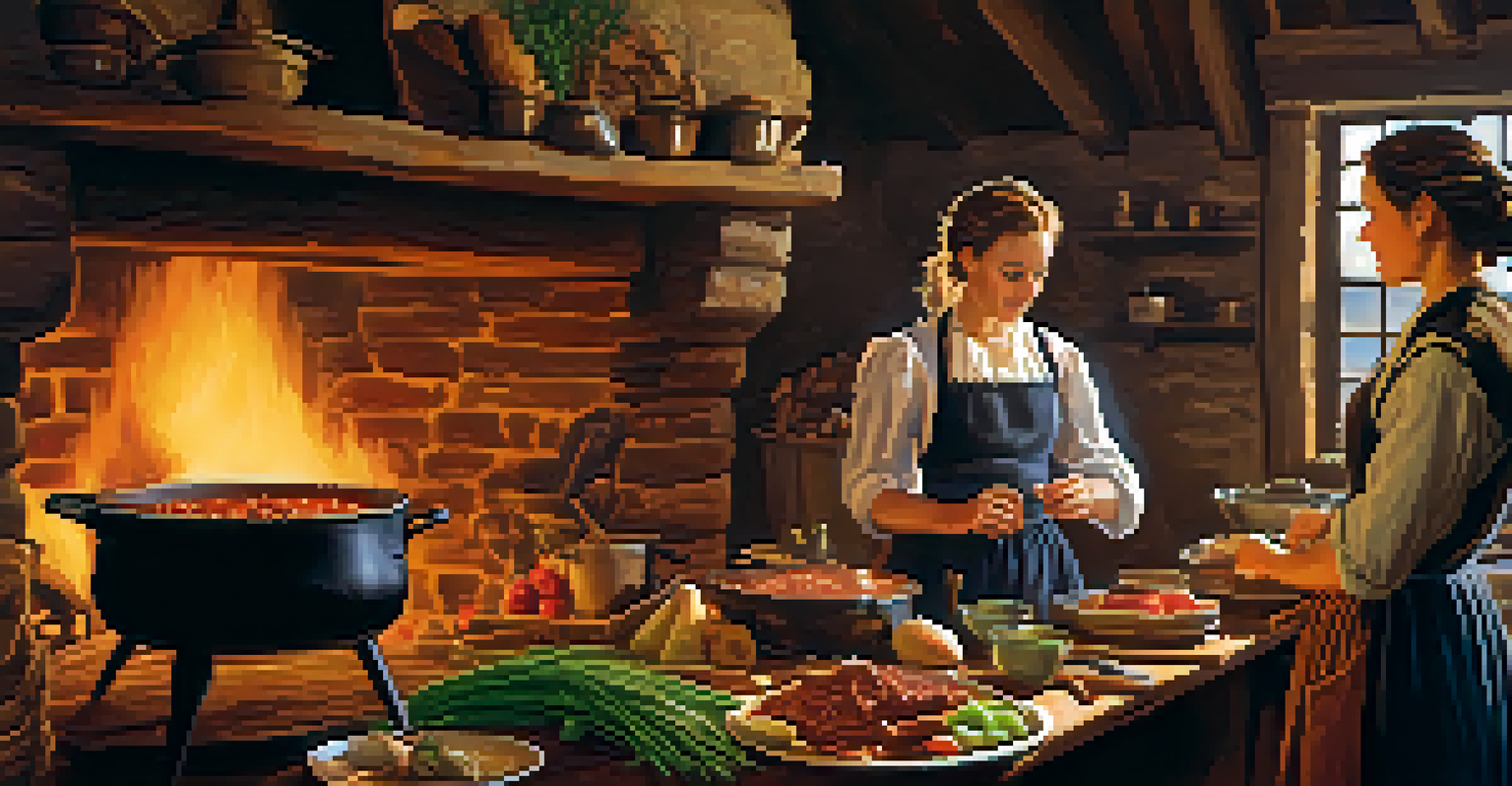Food from the French Revolution: Recipes of Change

The Culinary Landscape Before the Revolution
Before the French Revolution, the culinary scene was dominated by the aristocracy. Lavish banquets showcased extravagant dishes, often featuring rare ingredients and elaborate preparations. The common folk, however, struggled with basic sustenance, relying on bread and simple stews. This disparity in food access highlighted the growing social tensions in France, setting the stage for revolutionary change.
Food is a symbol of resistance and a means of survival.
The opulence of French cuisine was a stark contrast to the hardships faced by the lower classes. While the nobles indulged in delicacies, peasants were burdened by rising bread prices and food scarcity. This divide not only fueled discontent but also inspired a new culinary movement that aimed to democratize food. As the revolution approached, the call for equality echoed in kitchens across the nation.
Ultimately, this culinary divide played a significant role in shaping revolutionary sentiments. The desire for change extended beyond politics and social structures; it permeated the very fabric of French society, including its food culture. The revolution was not just a fight for political rights but also for a more equitable food system.
Food as a Symbol of Change
During the revolution, food transformed from a mere necessity to a potent symbol of change. The concept of 'liberty' extended to what people could eat and how they prepared it. As the revolution gained momentum, people began to reject the elaborate dishes of the aristocracy, embracing simpler, more accessible ingredients. This shift symbolized a break from the old regime and a step toward a more egalitarian society.

The new ideals of the revolution were reflected in the food prepared and consumed by the masses. Traditional recipes were adapted to include local and seasonal ingredients, promoting a sense of community and shared identity. The emphasis on hearty, nourishing meals resonated with the revolutionary spirit, as people sought to nourish their bodies while fighting for their rights.
Food as a Catalyst for Change
During the French Revolution, food transitioned from a basic necessity to a powerful symbol of liberty and equality, reflecting the aspirations of the people.
Moreover, food became a rallying point for the revolutionaries, with meals served during gatherings and meetings fostering camaraderie and solidarity. The kitchen table transformed into a site of political discourse, where ideas were exchanged as freely as bread was shared. This new approach to food reinforced the idea that culinary choices could reflect personal and collective values.
Notable Dishes from the Revolutionary Era
Several dishes emerged during the French Revolution that encapsulated the spirit of the time. One notable example is the 'Potato Soup,' a humble yet nutritious dish that became a staple for many. Potatoes, once shunned by the elite, gained popularity among the masses for their versatility and abundance. This dish symbolized the shift towards more accessible and egalitarian eating habits.
The revolution is not just about political change, but about reshaping the very essence of our daily lives, including what we eat.
Another revolutionary dish was 'Bouilli,' a simple beef stew cooked with root vegetables. This hearty meal provided sustenance for families during tough times, embodying the ideals of the revolution. Its preparation methods also reflected the emphasis on communal cooking, where families would gather to share not just food but stories and experiences.
These dishes not only nourished the body but also served as a reminder of the changes happening around them. As the revolution progressed, meals like these became symbols of resilience and unity, showcasing how food can reflect and influence social and political movements.
The Influence of Revolutionary Ideals on Cuisine
The revolutionary ideals of liberty, equality, and fraternity profoundly influenced French cuisine. Chefs began to embrace local ingredients and traditional cooking methods, moving away from the extravagant styles favored by the aristocracy. This culinary shift represented a broader societal change, as people sought to reclaim their culinary heritage and create a more inclusive food culture.
As a result, new cooking techniques emerged, focusing on simplicity and seasonality. The emphasis on fresh, locally-sourced ingredients not only made meals more affordable but also encouraged a sense of community among diners. This shift towards a more sustainable approach to cooking mirrored the revolutionary commitment to social progress and environmental stewardship.
Women Shaped Revolutionary Cuisine
Women played a crucial role in the culinary landscape by managing households and using food as a means of protest, highlighting their influence in social movements.
The legacy of this culinary revolution continues to resonate today. Modern French cuisine often celebrates regional ingredients and traditional recipes, reflecting the values established during this transformative period. Chefs and home cooks alike draw inspiration from this rich history, reminding us that food can be a powerful vehicle for change.
The Role of Women in Revolutionary Cuisine
Women played a pivotal role in shaping the culinary landscape during the French Revolution. As men left for battle, women assumed responsibility for feeding their families and communities. This shift not only elevated the status of women in the kitchen but also allowed them to influence the types of food being prepared and consumed. Their contributions were essential in ensuring that the revolutionary ideals were reflected in everyday meals.
Women also utilized food as a means of protest, organizing 'bread marches' to highlight the scarcity and rising prices of essential ingredients. These actions demonstrated the power of food as a tool for social change, as women rallied together to demand better conditions. By taking a stand for their families, they forged a connection between food, politics, and community activism.
The legacy of women's involvement in revolutionary cuisine is still felt today. Modern culinary movements continue to celebrate female chefs and home cooks who advocate for sustainable practices and social justice. Their contributions remind us that food has always been a powerful means of expression and resistance.
The Emergence of New Culinary Techniques
The French Revolution not only brought about social and political change but also spurred innovation in culinary techniques. Chefs began to experiment with new methods of preparation, utilizing simpler ingredients to create more accessible dishes. This creative shift laid the groundwork for modern French cuisine, blending tradition with innovation in exciting ways.
One notable change was the rise of the 'cuisine bourgeoise,' which focused on hearty, comforting meals that were both delicious and affordable. This style of cooking celebrated the flavors of the earth, emphasizing seasonal and regional ingredients. The techniques developed during this time allowed for greater creativity in the kitchen, paving the way for future culinary developments.
Legacy of Accessible Cuisine
The culinary innovations of the revolutionary era emphasized accessibility and community, shaping modern French cuisine and ongoing discussions about food justice.
As these new techniques took root, they transformed the way meals were prepared and enjoyed in France. The emphasis on simplicity and flavor over opulence resonated with the revolutionary spirit, encouraging chefs to push boundaries while honoring their culinary heritage. This evolution in cooking continues to influence chefs today, reminding us of the power of food to adapt and inspire.
The Lasting Impact of Revolutionary Cuisine
The culinary changes initiated during the French Revolution have had a lasting impact on the way we view food today. The emphasis on accessibility and community has shaped modern French cuisine, encouraging chefs to focus on local ingredients and sustainable practices. As we continue to navigate a complex food landscape, the revolutionary spirit remains a guiding force in our culinary choices.
Moreover, the lessons learned during this period about the importance of equitable food systems resonate in contemporary discussions about food justice. The revolution served as a reminder that access to nourishing food is a fundamental right, and efforts to address food insecurity continue to be a priority. This ongoing dialogue highlights the essential role of food in social movements and community building.

Ultimately, the legacy of the French Revolution is not just about the food itself, but also about how it connects people and reflects societal values. As we savor our meals, we can appreciate the rich history that has shaped our culinary practices, reminding us that food is a powerful agent of change.